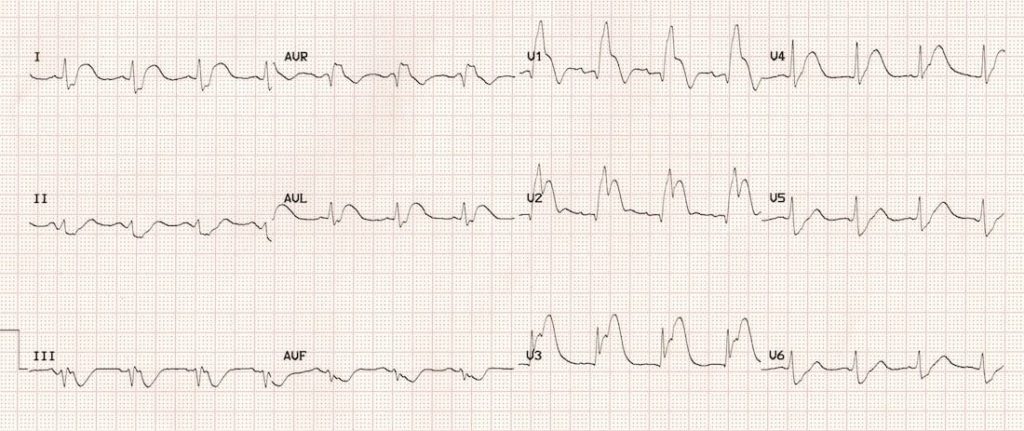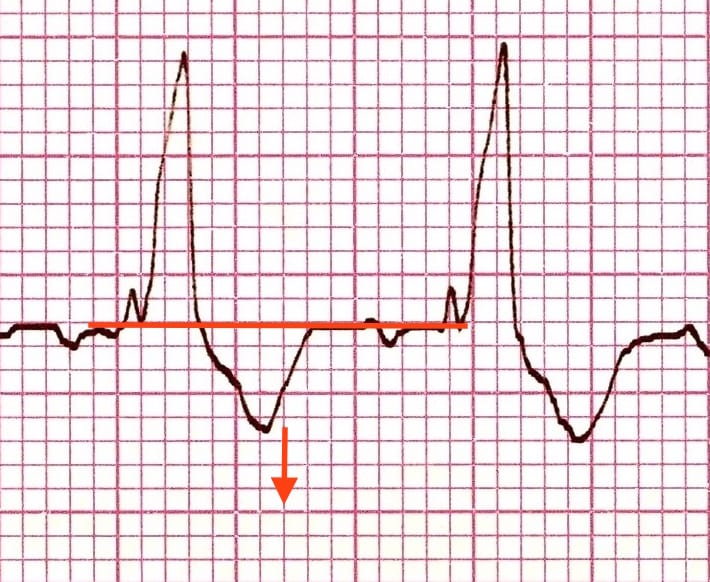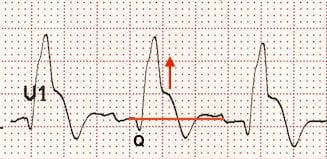ECG Case 034
Middle-aged patient presenting with chest pain. Describe the ECG.

Describe and interpret this ECG
ECG ANSWER and INTERPRETATION
Main Abnormalities
The ECG changes are partially masked by the presence of a right bundle branch block, but there is clear evidence of anteroseptal STEMI:
- Gross ST elevation in V1-3 (~ 5mm in V2)
- Convex ST elevation in I and aVL
- Reciprocal ST depression and T wave inversion in the inferior leads (II, III, aVF)
CLINICAL PEARLS
Predicting the Site of LAD Occlusion
This ECG demonstrates some markers of a very proximal LAD occlusion, involving the two most proximal branches of the LAD — the first septal branch (S1) and the first diagonal branch (D1).

Signs of occlusion proximal to S1
Signs of basal septal involvement:
- New RBBB — occurs due to septal infarction
- ST elevation in V1 > 2.5 mm
- ST elevation in aVR
- ST depression in V5
Signs of occlusion proximal to D1
Signs of high lateral involvement:
- ST elevation in aVL
- Inferior reciprocal ST depression > 1 mm
This patient arrived by ambulance following an out-of-hospital VF arrest and was taken straight to the cath lab where he was found to have a complete ostial occlusion of his LAD.
A Common Pitfall
This STEMI pattern is occasionally missed, when clinicians erroneously attribute the ST segment changes in V1-3 to RBBB alone.
However, the two patterns are quite different:
- Typical RBBB will have discordant ST depression and TWI in V1-3
- Superimposed septal STEMI will lead to ST elevation, Q wave formation, loss of the initial R wave and inversion of only the terminal portion of the T wave
Typical RBBB

RBBB + STEMI

References
Further Reading
- Wiesbauer F, Kühn P. ECG Mastery: Yellow Belt online course. Understand ECG basics. Medmastery
- Wiesbauer F, Kühn P. ECG Mastery: Blue Belt online course: Become an ECG expert. Medmastery
- Kühn P, Houghton A. ECG Mastery: Black Belt Workshop. Advanced ECG interpretation. Medmastery
- Rawshani A. Clinical ECG Interpretation ECG Waves
- Smith SW. Dr Smith’s ECG blog.
- Wiesbauer F. Little Black Book of ECG Secrets. Medmastery PDF
TOP 100 ECG Series
Emergency Physician in Prehospital and Retrieval Medicine in Sydney, Australia. He has a passion for ECG interpretation and medical education | ECG Library |
MBBS DDU (Emergency) CCPU. Adult/Paediatric Emergency Medicine Advanced Trainee in Melbourne, Australia. Special interests in diagnostic and procedural ultrasound, medical education, and ECG interpretation. Co-creator of the LITFL ECG Library. Twitter: @rob_buttner

